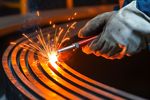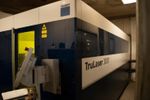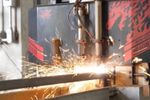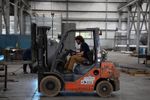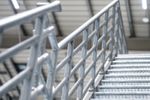What is the difference between a standard metal fabrication and a custom fabricated solution? A full-service fabricator can answer in one word – value.
Every custom metal fabrication begins with research to assess the appropriate materials and methods to cost-effectively produce each unique fabrication design. From design to delivery, the custom metal fabrication process is designed to produce more durable, quality results that deliver long-term value, from small metal accessories to massive steel silos.
Here are just a few examples of custom fabrication techniques that produce quality fabrications with long-term value.
Setting Design Intent
The metal fabrication design is essential to reaching the desired outcome, which is added value. What is the purpose of the fabrication? Maybe it is an industrial solution to provide roof access for two oil tanks with multiple entry points? Or perhaps you have a unique bulk storage design that calls for multiple custom components, such as a fully-insulated skirt with ground access?
A full-service fabricator can take a standard industrial plan or an engineering drawing to flush out a detailed design that will deliver the desired results for even the most complex fabrication. This may require refining and testing the design per industry-specific requirements or regulations, and identifying all the required components to serve as the building blocks for the final project.
This process is ideal for custom metal fabrications such as:
- Feed and grain tanks, silos, and hoppers, which may include dry solids metering or other material handling functionality.
- Liquid food storage with quality control capabilities, such as the ability to heat syrup to keep it in liquid form.
- Custom wrap-around spiral staircases with cross-over platforms for access to storage units of different heights.
Each custom fabrication may begin with MTC Shape Cutting, Pro Nest, or AutoCad files, or even an old-fashioned hand-drawn plan. But with the right engineering expertise, the design can ensure the project meets every value-add specification – before the actual fabrication begins.
Metal Cutting & Forming
Before cutting begins, the metal fabricator must assess what type of method is appropriate for the metal type and thickness. Laser cutting works effectively for delicate metal fabrications or for heavy steel plates that require strict tolerances. Lasers are not ideal for metal composites or materials that have impurities, due to the risk of spray reactions or potential surface defects.
When the fabrication requires complex steel metal shapes, plasma machines with Computer Numeric Control (CNC) can provide exceptional precision. Plasma tables are often used for carving circular holes or complex shapes out of thick metal plates.
Sawing is more appropriate for structural steel projects that require large beams to serve as the backbone for the final fabrication. For cutting simple shapes, plate shears are the most cost-effective option, which are more appropriate for carbon steel ductwork or durable metal bins.
Forming the metal may require bending, plate and angle rolling, or punching. It is critical to select the right machinery to deliver the desired result.
This metal forming equipment might include:
- Mechanical and CNC hydraulic press brakes.
- Plate rolling and angle rolling machines.
- Beam punches and CNC punching machines.
- Multi-function ironworkers for sheering, punching, and bending.
From thick carbon-steel plates to copper filigree, metal forming success is based on selecting the correct machinery to perform the task. A full-service metal fabricator will likely have all of the above equipment in-house, which can save both time and resources.
Custom Welding & Assembling
Custom welding and assembly techniques can ensure each metal fabrication meets specific industry standards. A custom fabricator with certified welders and a documented quality control program (QC) is more likely to meet the industry requirements that add value.
Before partnering with a metal fabricator, ask for documentation of welder certifications. These credentials should include:
- Adherence to Canadian Welding Bureau (CWB) standards.
- Welding Procedure Specification (WPS) that conforms to ASME Section 9 and welding practices that conform to the API-650 standard.
- Qualified to weld structural steel according to the American Welding Society AWS D1.1.
All assemblies and subassemblies should be tested together to ensure the final fabrication project functions as intended. The entire assembly process should be photographed and documented as part of a structured QC program.
The fabrication components should be shipped in the most complete form possible, especially for carts or ladders. Larger fabrications should be shipped with large subassemblies that can be assembled quickly onsite. This custom assembly process can dramatically reduce project timelines and labor expense.
Finishing to Add Value
From surface preparation to final finishing, Southern Metal Fabricators can extend the life of a custom metal fabrication for a tangible return on each project investment. From oil and gas tanks to feed and grain silos, our metal storage solutions can endure punishing outdoor conditions and protect the valuable content inside.
These finishing techniques include:
- Metal bead blasting or other surface prep to ensure paint or other coating adheres to the metal’s surface.
- Custom painting and drying with controlled paint booths to expedite dry times and proper hardening.
- Hot-dip galvanizing to coat every nook and cranny of the metal fabrication to prevent moisture from compromising structural integrity.
- Metal powder coating for more decorative finishing on detailed railings or metal signage.
From design to delivery, Southern Metal Fabricators offers finishing techniques like these and other fabrication services that reduce project labor costs and increase product ROI.
Give us a chance to fabricate and finish your custom metal fabrication project. We’re ready to say, “Yes, we can do that!” Contact us today.

